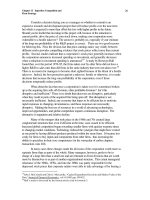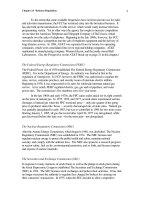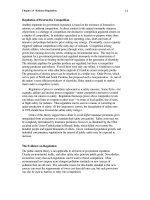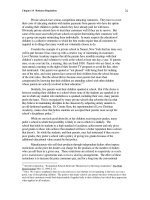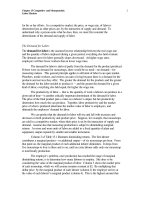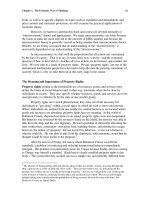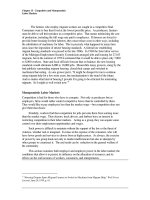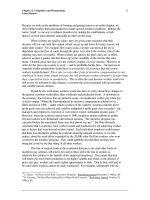Microeconomics for MBAs 54
Bạn đang xem bản rút gọn của tài liệu. Xem và tải ngay bản đầy đủ của tài liệu tại đây (44.05 KB, 10 trang )
Chapter 15 Competitive and Monopsonistic
Labor Markets
42
firms and also implies that firm size and executive pay should be positively related,”
which has been shown to be a pervasive feature of executive pay.
51
Hence, they not only
deserve higher salaries, they must be paid higher salaries because, if they are not, other
firms will hire them away.
Once someone is promoted to the executive ranks, his or her pay must also go up
significantly at the time of the promotion simply because the executive becomes more
visible to the rest of the relevant business community. Before the promotion, other firms
might be unaware of the executive’s abilities. After all, he or she might be toiling away
with a team of other workers where his or her abilities can be difficult to evaluate,
especially by outsiders. By promoting a person, a company announces to other firms that
they have found someone in their midst who is unusually productive and might even be
on a fast track to the top office in the firm. Outsiders no longer have to incur the costs
associated with searching through a large group of some other firm’s workers to find
productive managerial talent. They can “cherry pick,” limiting their picking to the
“cherries” identified by others.
The gap, which can be substantial, between the pay of those who are promoted
and those under them can be partially explained not so much by their actual productivity
as by the fact that the more productive workers at the bottom of the corporate ladder have
not yet been “discovered,” and, just as in the case of aspiring actors, managers understand
-- or should understand -- that being “discovered” can be as important in rising through
the ranks as actually acquiring the skills to undertake higher level jobs. Not all people
with the acquired skills (many of whom may be reading his book) will make it onto the
upper rungs of the corporate ladder.
Hence, outsiders can be expected to target those who are promoted elsewhere,
competing with the newfound executive’s own firm. Put another way, a firm must make
promotions count in terms of added pay and all the trappings that can go with higher
office as a defense against “executive raiders” intent on minimizing their search costs for
managerial talent.
Rising through the ranks probably requires a dose of luck and political acumen,
with both considerations having little to do with actual productivity, as many people
would measure it. Many workers no doubt grumble about executive pay with cause.
They, the grumblers left behind, may in fact be more productive than some of the people
above them; they just haven’t met with the requisite measure of luck. Also, being
discovered often requires work at getting oneself noticed through, for example, self-
promotion, and the time devoted to such activities can be time taken away from
improving one’s managerial skills. Moving up the ladder on the fast track requires not
just managerial skills per se, it requires some optimum combination of skills and self-
promotion and schmoozing. There are no doubt many workers left behind who are
indeed more productive than those who are promoted; they just never found the right use
of their time. In effect, they have acquired “too much” in the way of basic skills and not
enough of, say, political savvy.
51
Sherwin Rosen, Contracts and the Market for Executives (New York: National Bureau of Economic
Research, Inc., working paper 3542, December 1990), p. 7.
Chapter 15 Competitive and Monopsonistic
Labor Markets
43
Just because pay differences between the ranks may be partially based on luck, it
does not follow that the differentials should be eliminated, even if they could, which they
probably could not be, given competitive forces. All corporations can be expected to do
is establish promotion and pay policies that will enable them to achieve a reasonable
measure of success -- not perfection -- in picking the “best” people for higher level jobs.
If they sought perfection in the selection process, the companies would surely fail simply
because mistakes are usually unavoidable in most complex business/employment
environments. In their quest for perfection, the companies would also incur excessive
search costs, making them uncompetitive vis a vis other companies that were willing to
accept occasional mistakes.
Executive Pay As a Motivation for Workers
The pay of executives may also be “excessive” for another reason involving the
difficulties of selecting managers. When people are hired at the bottom of the corporate
ladder, upper level managers may have only a rough idea as to whom among the large
group at the bottom are worthy of higher ranks. They can, for example, check references
and look at their workers’ educational records -- what schools they attended and what
grades they made -- but such factors are not always highly correlated with a willingness
on the part of people to work hard and smart in given corporate environments.
How can upper-level managers motivate lower-level workers to reveal how hard
and smart they are, at the limit, willing to work? Piece-rate pay and two-part pay
contracts, which we have covered, can help. So can bonuses. Another incentive system
used is an executive “tournament,” which is held among lower-level workers, with the
“prize” being a promotion to the next rung on the corporate ladder.
Any overt or covert announcement of the tournament can have two effects. First,
it can cause the workers to compete among themselves for the prize. All workers can
work harder for the prize with the added value being claimed by upper managers and
owners who announce the competition.
52
Second, aware of the competition among
employees, workers who might be hired at the lower levels in the firm with the
tournament will self-select. Those who think that they will not “win,” and who will
therefore suffer the cost of the competition but will not receive a “prize,” will self-select
out of employment with the firm.
Therefore, the tournament will tend to be concentrated among those who have a
degree of confidence in their abilities, given the competition. Workers who self-select
52
The executive tournament can have much the same effect as prizes do in real golf tournaments: they
improve performance. One study found that by raising the prize money to a hundred grand or more, the
scores of the golfers went down by 1.1 strokes over the course of a 72-hole tournament. Apparently, the
prize money had its greatest effect in the later rounds when the players were tired and needed to
concentrate on every shot [Ronald G. Ehrenberg and Michael L. Bognanno, “Do Tournaments Have
Incentive Effects?” Journal of Political Economy, vol. 98 (December 1990), pp. 1307-1324]. In addition,
bonuses appear to be sensitive to managerial bonuses with the future performance of managers improving
with current bonuses [Lawrence M. Kahn and Peter D. Sherer, “Contingent Pay and Managerial
Performance,” Industrial and Labor Relations Review, vol. 43 (February 1990), pp. 107S-120S)].
Chapter 15 Competitive and Monopsonistic
Labor Markets
44
into the competition can then compete in the knowledge that their cohorts at work will,
on average, be more productive than they would have been if the tournament were not
held. Their expected lifetime pay with the firm should, accordingly, mirror the higher
expected productivity of the workers hired.
In order for the tournament to have the intended effect, the pay upon promotion
(or winning) must be attractive to all who compete at the lower levels -- after the higher
pay is discounted by the probability that any one person will receive it. In group settings,
most reasonable worker/competitors will likely assume that the probability of their being
selected for the promotion is significantly below 1.0 (or certainty). After all, when they
start the contest, the competitors will have only limited information on just how hard and
smart their cohorts will apply themselves. And pay and the probability of promotion do
appear to be inversely related. According to one study, pay increments with promotions
increase substantially between managers at adjacent levels within corporations, and the
pay increments when promoted vary inversely with the prospects of being promoted,
which should be expected: the stiffer the competition (and the lower the prospects of
being promoted), the greater the pay increase must be in order to maintain the drive
among managers to be promoted.
Those participating in tournaments should demand a higher expected pay because
tournaments are by nature “games,” meaning the outcome is dependent upon how the
other participants play, or seek the prize. This aspect of tournaments necessarily
introduces some variance in the outcomes of tournaments, which implies unavoidable
uncertainty into how individual participants should “play” (or compete). The pay should
be expected to compensate the participants for the problems associated with the inherent
risk and uncertainty (vis a vis other pay systems – for example, piece rate – that simply
require the workers to maximize their output without consideration to what other workers
do).
53
Therefore, the value of the prize (which includes an “overpayment”) must be
some multiple of the total costs each worker can be expected to expend in seeking the
promotion. The lower the probability of any one worker receiving the prize, the greater
must be the value of the prize -- the overpayment, or the gap between the promoted
person’s actual worth to the company and the pay (plus fringes and perks). If the gap
were nonexistent, then the prospects of promotion would not have the intended impact a
tournament is supposed to have on all workers’ productivity.
54
53
For a discussion of these points and some experimental evidence that suggests that the variance of
outcomes in tournaments is greater than the variance in outcomes of piece-rate pay systems, see Clive Bull,
Andrew Schotter and Keith Weigelt, “Tournaments and Piece Rates: An Experimental Study,” Journal of
Political Economy, vol. 95 (no. 1, 1987), pp. 1-33.
54
See Jonathan S. Leonard, “Executive Pay and Firm Performance,” Industrial and Labor Relations
Review, vol. 43 (no. 3, 1990), pp. 13s-29s. Also, consistent with the Leonard study, another study found
that pay increases rapidly with higher ranks, with the CEO earning $100,000 more a year than vice
presidents compared to lower-level managers earning $10,000 to $30,000 more than their underlings
[Richard A. Lambert, David F. Larcker, and Keith Weigelt, “The Structure of Organizational Incentives,”
Administrative Science Quarterly, vol. 38, no. 3 (September 1993), pp. 438-462. However, another study
drew a contradictory conclusion: that the greater the number of vice presidents (which, presumably means a
lower probability of being promoted), the greater the pay gap between the CEO and the vice presidents [C.
Chapter 15 Competitive and Monopsonistic
Labor Markets
45
Put another way, promoted workers usually get substantial pay increases with
larger offices and more perks not because they necessarily “deserve” all that they get, but
because the firm may want to validate the tournament and to hold other tournaments in
the future. The executive’s “overpayment” is covered by the firm not so much by what
the chosen executive actually does (although, as noted, that can be an important factor),
but by the added output generated by the competition among all those who seek
promotion.
Why is it that pay rises so fast as people are promoted through the ranks? Again,
there is, no doubt, some correlation between rank and abilities, although it is by no means
perfect. The higher up the ladder, the greater the abilities of executives -- as a tendency.
However, we suspect that pay differences have a lot to do with probabilities. Someone at
the bottom looking up the ladder can figure that the probability of his or her actually
making it through the rungs falls the further up the ladder he or she looks. A worker at
the bottom might give him or herself a probability of 20 percent of making it to the first
rung, given the few people in the immediate work group, but the worker might give
himself or herself a probability of .001 percent of making it to the top rung (and even that
probability might be overstating the prospects of success), given that he or she might be
competing with everyone in the organization and those who may join the organization in
the future. And the worker is likely to reason that the greater the number of workers at
the bottom and the greater the number of rungs in the corporate ladder, the smaller the
probability of reaching the top rung.
Executive pay, in other words, must rise disproportionate to productivity just to
account for the declining probability of any one person making it through the rungs. The
purpose of the progressively larger “overpayments” at the higher and higher rungs is not
necessarily so much designed to promote social justice among workers, although such
considerations are rarely totally overlooked either, but it is to properly motivate all
workers who are contemplating moving through the corporation.
The Growing Gap between
Executive and Worker Pay
Again, why is it that the pay gap between top executives and workers at the bottom has
been growing over the last decade or so? Popular wisdom has it that the growing gap can
be attributable to insane corporate policies that are stacked in favor of executives by
board members who were appointed to their positions to do what they have done, raise
the income of the executives at the expense of owners and lower-order workers.
According to Graef Crystal, a prominent critic of corporate pay, boards of directors not
only raised their CEO pay by an average of 21 percent in 1995 (several times the rate of
inflation), but they raised pay for reasons that are hard to identify. Ten percent of the
variation of pay among top executives can be explained by company performance: better
performing companies tend to pay their CEOs better. Twice that percentage (21 percent)
O’Reilly, Brian Main, and G. Crystal, “CEO Compensation as Tournament and Social Comparison: A Tale
of Two Theories,” Administrative Science Quarterly, vol. 33 (no. 3, 1988), pp. 257-274.
Chapter 15 Competitive and Monopsonistic
Labor Markets
46
of the variation can be explained by company size: larger firms tend to pay their CEOs
better. That leaves 69 percent of the variation unexplained.
55
There is always a hint of truth in such claims, but we aren’t willing to concede
that none of the unexplained variation (just because it isn’t picked up in regression
analysis) in corporate pay has a rational basis. Corporate boards do some pretty stupid
things from time to time (which market pressures force them to correct or suffer the
consequences). However, we suspect the growing gap has something to do with the
actual impact of executives on corporate earnings, given their decisions can be more
important in a rapidly changing global economy, and with the declining opportunities of
workers making it to the executive suite, given the “flattening” of corporate command-
and-control organizational structures. The probability of someone becoming a chief
executive officer has simply gone down at the same time that the risk of being an
executive has gone up.
We should also not overlook the prospect that the high pay of the top executives
in a firm may be a means of driving down the pay of the workers at the bottom. Indeed,
that can be the purpose of the overpayment of the people at the top. By raising the pay of
executives, more people can be attracted to the firm in the hope that they will eventually
make it to the top and receive the overpayments. In this sense, there is not only a gap
between higher and lower worker pay, there is also a gap between what the lower
workers are paid and their expected pay, and the gap between the actual and expected pay
of lower workers can expand as the gap between the actual pay of the lower and higher
workers increases.
All of this means that workers may indeed be right when they complain that their
chief executive could not possibly be worth the zillions that he or she makes. “Worth” is
not necessarily the point of the pay. Properly aligning the incentives of workers
throughout the organization is the point that should not be overlooked.
56
The overpayments provided executives can, of course, be fortified by market
competition for executive talent. All firms interested in maintaining proper incentives
can compete with each other for executive talent, but their competition can be constrained
by the fact that they cannot wipe out their overpayments. If they did, then incentives, and
production, throughout their firms could be impaired.
55
Graef Crystal, “Average U.S. CEO Boosted Pay 21% in ’95, to $4.5 Million,” Los Angeles Times, May
26, 1996, p. D4.
56
We don’t want to be accused of playing to the view that executives are the only group of workers who
can be “overpaid.” We presented arguments much earlier in the book as to why some workers are
“overpaid.” Obviously, in many firms there are also workers who become good at working the pay system
to their advantage without their bosses noticing. They can end up overpaid for a very long time. Also we
are sympathetic to the view that many executives are probably “underpaid,” given how little their rewards
go up with their executive actions. At the same time, many workers may be overpaid, given how little they
can affect their company’s revenues for the wages they receive. A contrarian view is developed at length
by Robert H. Frank, Choosing the Right Pond: Human Behavior and the Quest for Status (New York:
Oxford University Press, 1987).
